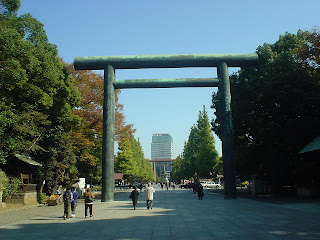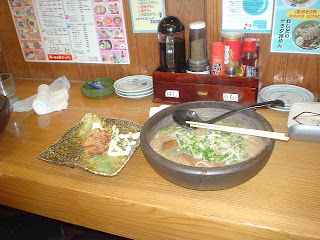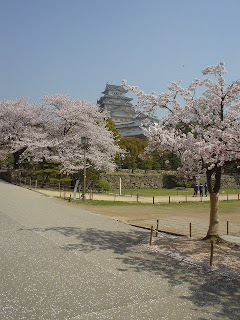I have recently returned from Tokyo’s Yoyogi Koen where I attended the 2007 Japan Association of Language Teachers (JALT) annual conference. This is usually in some location far-flung from Kobe, which adds to the novelty, travelling in the fine autumn weather. However, as a result, I usually spend the first morning on the road/railway which means I miss the early sessions despite having paid full-whack for the conference fees. So this year I decided to travel up to the Eastern Capital (Tou-Kyou 東京)by overnight coach, so as to arrive bright and early and register at 9:00 on Friday, Nov 23rd when it all kicked off. This did not seem like an unreasonable plan, having done a similar thing some seven years ago when a friend of mine from the UK was taking part in an international folk culture event as part of a Morris Dancing team. That time though, the coach was equipped with full-recliner seats, not unlike those in First Class on a 747 Jumbo.
The best-laid schemes of mice and men, gan aft-a-gley...
I was somewhat dismayed to find that the Sannomiya–Tokyo Station Dream-Liner was just a common-or-garden long distance coach and there were nine hours of travel ahead of us. I did snatch a morsel of REM sleep sometime after a 3 am service station stop, evinced by the fact that I dreamed a dream. It was a rather strange dream, involving me down a lead mine in Weardale, County Durham, with someone long since deceased, searching for semi-precious stones and the like for his lapidary collection and finding nothing but old, broken clay pipes left behind by the miners of long ago. An old memory no doubt, I _have_ been there and done that, many times. The dream came to a rather abrupt end when an earthquake started and the roof began to cave in, a seismic phenomenon which Weardale is not noted for.
I awoke in terror, to find that the bus was rumbling over an uneven surface left by construction work which was the source of the shaking. The rosy-fingered dawn was breaking and I spent the remainder of the journey watching heavier and heavier traffic heading out of Tokyo for the 3-day weekend, while our progress was relatively unimpeded.
I grumpily alighted from the Dream-Liner at Tokyo Station exactly on time at 07:15, something the Japanese are uncommonly good at. I then had to travel approximately half-way round their version of London’s Circle Line, known as the Yamanote-Sen. There is a quicker way across the intervening distance, but it involves going down into the bowels of the earth to a subway line, whereas the Yamanote always remains on the surface and is hence more civilized, in my humble opinion. At Shinjuku I alighted again and went in search of breakfast, which was soon found at a 24-hour diner who served me with a bacon-cheese-tomato toastie and a nice cup of blended Joe. Now the day was truly beginning, I felt replenished and ready for anything.
However, the relatively short journey from Shinjuku to the conference site involved a lot of seemingly unnecessary clumping up and down stairs amid throngs of people so I was grumpy again by the time I had arrived and completed the registration procedure. More coffee was needed and in the process of getting this, scanning the conference handbook Friday schedule and bumping into people not-seen-for-ages, it was 11 am before I was in any state for going to a presentation of any kind. I could have had a decent night’s sleep, taken an early Shinkansen (or even a flight) and achieved the same result. These kinds of lessons learned are the best remembered.
One very common topic of conversation was the Ministry of Justice’s recently introduced anti-terrorism immigration policy affecting all non-Japanese (with a limited number of exceptions). As of November 20th all such persons must be fingerprinted (index fingers of each hand) and have a digital photograph taken for the records. When I first heard about this, in late August, I was not unduly bothered. After all, the MoJ already had the print of my right-hand index finger on record and a photo (updated every five years for the ID card) and I have had the status of eijuu-ken
(永住権)
for more than fifteen years. Surely they didn’t want to do this to me?
Think again laddie. The MoJ claim they destroyed all fingerprinting records (apart from those of convicted felons) in 2000 when the practice of fingerprinting for a visa of more than 90 days duration was abolished in the face of mounting protests about discrimination at home and abroad. It has only taken them seven years to reinstate the practice and now on entry and re-entry for ever and ever. It was suggested that they introduce a special gate for permanent residents like me who could pre-register their biometric details, so as to avoid interminable queues. They have only agreed to provide one such gate, at Narita in the Kanto region serving Tokyo. People using other points of ingress like KiX in the Kansai or Chubu International in the Tokai can go and whistle Dixie for all they care.
I can understand that a case can be made for collecting such biometric data—once. There are a lot of unpleasant people around in this world, and if it means they can be apprehended more easily I have no problem in meeting the letter of the law—once. Doing the same thing repeatedly is a nonsense, as is the refusal to provide a pre-registered gate anywhere else but Narita. It is a kick in the teeth for those of us who have lived here peaceably for decades, paid our taxes and generally tried to fit in to a different culture.
I did not meet one person who was in favour of this new policy. Some have gone to some interesting lengths to illustrate their opposition to it.

If anyone would like to buy one of these T-shirts, point your browser to:
where they can be purchased in Adult sizes XXL down to XS. I was informed by the designer that the print on the shirt is actually of his big toe, not his index finger.
As I do not plan to travel outside of Japan for another 12 months or so, I hope common sense will prevail and some amendments will be made to this policy in the meantime.
On the morning of Saturday 24th November, a friend of mine and I decided to take some time out of academia and do a bit of sightseeing. We decided to go to Yasukuni Jinja (靖国神社)which translates literally as ‘Pacifying the Nation Shrine’. This place was originally constructed in 1869 by order of the Meiji Emperor, as a war memorial to commemorate those who had died in the Boshin War, fighting on the side of the Restoration. Since then it has become a general war memorial using Shinto rites to deify the spirits of all those who have given their lives fighting for Japan and the Emperor up till 1951. This includes former colonial subjects from Taiwan and Korea, not only Japanese. However,
“One of the criteria for enshrinement at Yasukuni is that a person be listed as having died while on duty (including death from illness or disease) in the war dead registry of the Japanese government. According to documents released on 28 March 2007 by the National Diet Library of Japan, Health and Welfare Ministry officials and Yasukuni representatives agreed during a meeting, on 31 January 1969, that Class-A war criminals judged at the Tokyo Trial were "able to be honored" and decided not to make public the idea that Yasukuni would enshrine those criminals.[2] On October 17, 1978, 14 Class A war criminals (convicted by the International Military Tribunal for the Far East), including Hideki Tojo, were quietly enshrined as "Martyrs of Shōwa" (昭和殉難者 Shōwa junnansha), ostensibly on the technicality that they were on the war dead registry. They are listed below, according to their sentences:
* Death by hanging:
Hideki Tojo, Itagaki Seishiro, Heitaro Kimura, Kenji Doihara, Iwane Matsui, Akira Muto, Koki Hirota
* Lifetime imprisonment:
Yoshijiro Umezu, Kuniaki Koiso, Kiichiro Hiranuma, Toshio Shiratori
* 20-year imprisonment:
Shigenori Togo
* Died before a judicial decision was reached (due to illness or disease):
Osami Nagano, Yosuke Matsuoka
The enshrinement was revealed to the media on April 19, 1979, and a controversy started in 1985 which continues to this day. For China, North and South Korea, and other nations that suffered from Japanese invasion and imperial rule, the shrine is a symbol of Japanese fascism and extreme aggression. Liberal, socialist and communist groups in Japan also take issue with the shrine for similar reasons.”
Quotation from Wikipedia http://en.wikipedia.org/wiki/Yasukuni_Jinja
The entrance to the shrine is marked by one of the largest torii gateways I have ever seen, built of iron and quietly rusting away in the November sunlight.


“A documentary-style video shown to museum visitors portrays Japan's conquest of East Asia during the pre-World War II period as an effort to save the region from the imperial advances of Western powers. Displays portray Japan as a victim of foreign influence, especially Western pressure. The museum fails to portray atrocities committed by the Japanese Imperial Army such as the Rape of Nanking.
A pamphlet published by the shrine says: "War is a really tragic thing to happen, but it was necessary in order for us to protect the independence of Japan and to prosper together with our Asian neighbors." It also says that Japanese POWs executed for war crimes were "cruelly and unjustly tried" by a "sham-like tribunal of the Allied forces."[2] Their position is based on the WWII-era argument from the Japanese government that the country had never signed the Geneva Convention, and was not a signatory of any enforceable international war crimes agreement. Therefore, in their opinion, the convictions were labels placed upon them by an organization to which they did not belong.
The shrine's English-language website defends Japanese activities prior to and during World War II, by stating: "War is truly sorrowful. Yet to maintain the independence and peace of the nation and for the prosperity of all of Asia, Japan was forced into conflict." (Quotation from Wikipedia, as above).
As we left the shrine to make our way back to the conference we noticed a man had set up a display with photos and video screens to show that the 1937 Rape of Nanking never took place and that it is all a fabrication of the evil Chinese Communist party. Take a look...
http://www.history.gr.jp/~nanking/index2.html
You will notice that the main gist of these people’s arguments is dissent regarding absolute numbers of people who were killed. In this sense they are similar to the neo-Nazi holocaust denial people. They also forcibly point out that the Chinese Communist Party has been guilty of far worse massacres since 1947 and that they have no business in criticizing the defunct Imperial Japanese Army for human rights violations.
My own take on this controversy is — a plague on both your houses. The past cannot be undone and while we should not simply forget about it, continually digging it up in order to heave motes and beams about serves no purpose. Up until recently, the Prime Minister of Japan would make official visits to Yasukuni Jinja, mainly in order to placate the right-wing financial backers of his party. However, the last leader Mr Abe notably did _not_ make a visit during his short tenure, and so far the current incumbent, Mr Fukuda has indicated no intention of doing so. As a result relations between Japan and the PRC have become more cordial and a Chinese warship made a courtesy call to the port of Tokyo last week, the first such visit since 1934. May common sense prevail...
All of this got me thinking about my own religious upbringing at the Church of St Mary and St Cuthbert in Chester-le-Street, County Durham.
This church was originally established in 883 by a band of monks in flight from the ravishing Danes who had driven them from their priory at Lindisfarne. Use of the land was granted by King Alfred ‘the Great’ and this is signified by the striking red colour of the cassocks still worn by the choir. It is claimed that the Bible was first translated into English there, but this is uncertain. Certainly, the Lindisfarne Gospels had their first resting place here after removal from Holy Island, but the form of Old English used in them is now unintelligible to the modern reader.
Anyway, it was here that the writer got his first taste of Christianity, first at Sunday School and later as a soprano chorister.

We were paid for this stuff of course, one old penny (1d) for each choir practice (Tuesday & Friday) and the princely sum of two shillings and sixpence (2s/6d) for a Saturday wedding, plus the chance to participate in the ‘scramble’ when the bridegroom would, following tradition, empty his pockets of loose change into the street for urchins to fight over.
My main reason for being a chorister was not to sing in the choir but to play football for its team, something I pursued more with passion than any skill. In later years, when the good Reverend’s sermons began to cloy, I would play with Matchbox cars or toy soldiers on the choir stalls, under the baleful glare of the choirmaster, Mr Caldwell, who was always threatening to confiscate them but never remembered to do do. Other people would imagine the vicar was a cricket umpire and estimate the score by the positioning of his hands during the sermon. It recently occurred to me that we would sing the lyrics to hymns and anthems most angelically without the slightest notion of what they meant;
doesn’t make a lot of sense even now
In the final year of my choir career a new rector, the Reverend Ottoson, appeared and took over the Sunday sermons. He was a real wild-fire compared with his staid predecessor and introduced all manner of new ideas to C of E services. I first heard the modern hymn Lord of the Dance from him.
In the fullness of time, my soprano voice broke and was 'like nowt nor summat’ for a year or two (to quote my grandmother) and so I was dismissed from the choir. I became a campanologist for a time, as the church has an impressive eight-bell peal, but became disinterested due to factional politics within the group.
To finish with I should make comment on something which is making headlines in Britain right now, particularly in the tabloid press. A good-hearted English teacher from Liverpool, about my age, name of Gillian Gibbons, decided to work in Sudan so as to use her teaching skills to benefit the children of that strife-torn land in some way. One day, she obtained a teddy bear from somewhere and decided to adopt it as the class mascot. She held a class competition to decide on a name for the soft toy as part of a study of animals and their habitats. The name that was decided on by democratic vote was Muhammad, which is a very popular name for baby boys. It is also the name of the Prophet of Islam and this has caused her to be imprisoned for blasphemy for 15 days and subsequently deported. There have been reports of vengeful mobs burning her in effigy and demanding that she face a firing squad for her heinous crime.

That's all folks! Till next time.



























